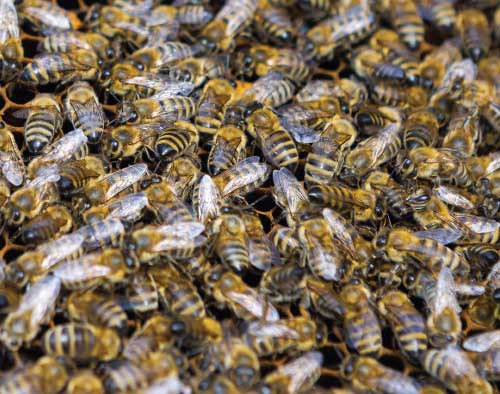The role of guardian bees and defense techniques
Hive Defense is essential for a swarm to survive external attacks. In recent years, bees have gone through very difficult periods due to the arrival of new predators . Among these we find above all the wasp velutina and the Asian hornet.
Bees have adapted (in part) to the strength and aggressiveness of the new predatory species, so much so that they have developed new techniques to suppress attacks. The wasp velutina and the mandarinia are very advantageous in terms of strength and size, so much so that the methods of defense of the bees have often been useless.
In recent years we have seen the decimation of entire colonies. Bees have suffered severe weakening both due to external factors such as pollution, and due to new predators that are enemies of bees.
But how do bees defend the hive? What techniques do they use to kill predators? Let's find out together!
How many bees are there in each hive?
Each hive has numerous individuals. The higher the number of components, the greater the strength of a swarm. Usually a strong colony has around 60,000 bees .
The number of bees that make up a hive, however, changes according to the time of year. The variability of the components is very influenced by the season. In fact, in winter, about 20,000 bees are found in the hive.
The latter actively participate in the heating of the hive by joining in a sphere structure that allows them to stay warm. This structure is called glomere and is used by bees to survive the winter.
With the arrival of warmer seasons such as spring and summer, the number of bees in the hive starts to rise again. A new collection cycle begins, the larvae present in the cells reach the adult stage and the population begins to grow until reaching the maximum expansion (in the middle of summer).
Now that we know how many bees there are in a single hive , we can imagine how difficult it is to coordinate the work of each individual. The bees, however, have managed to create an extraordinary communication mechanism that allows them to divide up tasks, exchange information and keep the hive in the best possible way.
The division of roles in the hive also includes the creation of effective defense strategies to survive enemy attacks.
The division of tasks
Within the hive, the rules and tasks to be respected are very strict and well defined. There are different roles that bees play. Among these we find:
- Foraging bees : take care of collecting nectar and pollen from flowers and plants. They are also responsible for the production of honey and the storage of the latter inside the cells.
- Nurse bees : these bees feed the larvae inside the cells and also create royal jelly for the larvae located in the royal cells.
- Guardian bees : their task is to defend the hive and communicate the presence of threats to the swarm .
- Fuchi : they are male bees. They have a marginal role and are activated only in the mating phase with the queen.
- Queen bee: heart of the whole hive, the fertile queen bee guarantees the exchange of bees by laying eggs throughout her life.
- Sweeper bees : these bees keep the hive clean by removing waste or carcasses.
- Worker bees : they take care of whatever needs the bee family has. The workers carry out all the activities we have just listed in a coordinated way (they can be foragers, nurses, sweepers, guardians, etc.).
The noise of the swarm when a threat is present

When predators approach the hive to attack the colony, the guardian bees immediately communicate to the rest of the swarm that the family is in danger. Guardian bees are usually elderly bees that position themselves at the entrance to the hive to prevent access to predators.
Guarding the hive's access point means being exposed to numerous risks. For this role, the oldest bees are selected precisely because they are considered more expendable.
The communication method of bees is rich and complex. When bees sense a threat, they perform a very rapid vibration of the wings and thorax producing a truly unique sound result.
On an acoustic level it is possible to perceive real “whistles”. It is a kind of alarm cry. When that happens, the entire colony prepares for defense.
If the hive is attacked by a wasp, this background buzz escalates up to seven times. In addition, some of the worker bees begin to emit the "anti-predatory whistles". The bees that are sounding the alarm also change their behavior, and begin to flutter frantically around the hive.
Bee defense techniques
The main defense technique of bees is to surround and heat the predator until it suffocates. The bees usually join one another on the invader's body. At best, the predator dies quickly and the hive is safe.
In cases such as that of the vespa velutina or the vespa crabro, very often these techniques are not sufficient to suppress the attacks. Bees use to cover their hives with animal dung to keep predators away.
Sale of queen bees, cores and bee packs
Are you a beekeeper? Do you need bees for your farm? Buy api online! Apicoltura Laterza deals with the production and sale of Ligustic queen bees and Buckfast queen bees , parcels, cores and swarms!
Buy now on: www.apicolturalaterza.it

 English
English  Italiano
Italiano  Estonian
Estonian  Finnish
Finnish  Français
Français  Deutsch
Deutsch  Latvian
Latvian  Norsk
Norsk  Polski
Polski  Română
Română  Español
Español  Svenska
Svenska